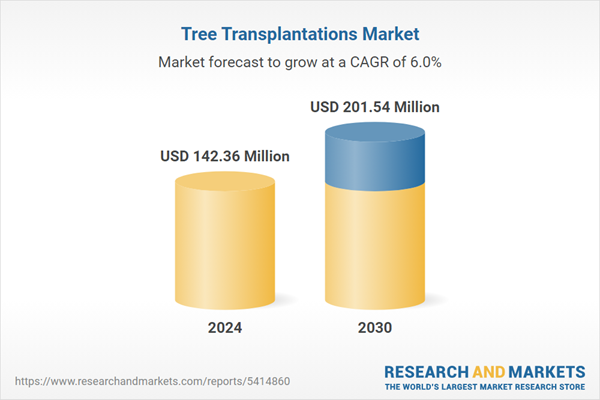Speak directly to the analyst to clarify any post sales queries you may have.
10% Free customizationThis report comes with 10% free customization, enabling you to add data that meets your specific business needs.
Key Market Drivers
Increasing Cases of Deforestation
Increasing deforestation globally is not just an environmental concern but also a pressing issue that may potentially increase the demand for tree transplantation. As deforestation strips the Earth of its green cover, the need to restore these lost patches becomes paramount. Tree transplantation is an effective method that allows mature trees to be moved from areas under threat to safer locations where they can continue to thrive. This technique not only conserves the trees but also helps in maintaining the overall biodiversity of the region. Moreover, as the global community becomes more aware of the devastating effects of deforestation, the demand for solutions like tree transplantation is expected to surge.Government regulations, international agreements, and proactive initiatives are likely to enforce tree transplantation as a mandatory requirement for developmental projects, thereby significantly boosting its global demand. Furthermore, with advancing technology and improved methodologies, tree transplantation is becoming more feasible and accessible, encouraging its adoption worldwide. By saving trees from deforestation, we're not only preserving their inherent value but also combatting the adverse effects of climate change, thereby shaping a healthier and more sustainable world.
Key Market Challenges
High Transplantation Costs
High transplantation costs are emerging as a significant barrier to the global demand for tree transplantations. Tree transplanting, the process of moving trees from one location to another, demands specialized skills, expensive machinery, and careful planning, all of which contribute to its high cost. As the world grapples with economic instability, many public and private entities are finding it challenging to allocate substantial funds towards this environmentally beneficial practice, thus reducing its demand. Additionally, the high cost of care post-transplantation, including watering, fertilizing, and protecting the tree from pests and diseases, further escalates the total expenses. These combined factors make tree transplantation a costly endeavor, deterring potential customers and decreasing its global demand. It is important for stakeholders to understand these cost implications and explore ways to make tree transplantation more affordable, as it plays a crucial role in urban development and environmental sustainability.Key Market Trends
Rise in Trend of Creating Green Roofs in Urban Architecture
The burgeoning trend of integrating green roofs into urban architecture is expected to significantly drive the global demand for tree transplantation. In response to escalating environmental concerns and stringent building regulations, architects and urban planners are increasingly incorporating green roofs into their designs. This eco-centric architectural approach incorporates verdant foliage onto rooftops, contributing to carbon sequestration, heat insulation, and rainwater retention, thus enhancing urban sustainability.These rooftop gardens necessitate the transplantation of mature trees, which are better equipped to withstand the harsh rooftop conditions compared to their younger counterparts. Additionally, mature trees offer immediate visual impact and canopy coverage, accelerating the achievement of green roof benefits. Consequently, as cities worldwide continue to adopt this green architectural concept, tree transplantation services, fundamental to the creation and maintenance of green roofs, will likely experience heightened demand. Furthermore, as the need for urban greening intensifies, the tree transplantation market could see significant growth, propelled by the rising trend of green roofs.
Key Market Players
- The Davey Tree Expert Company
- Big John Manufacturing Co.
- Damcon B.V.
- MPG Machinery Production Group Inc. Co.
- Xuzhou HCN Machinery Technology Co., Ltd
- Bracke Forest AB (Fassi Group)
- G K Machine, Inc.
- Terrateck SAS
- Vinca Horticulture & Landscape Private Limited
- Mecas Facility Management Services
Report Scope:
In this report, the Global Tree Transplantations Market has been segmented into the following categories, in addition to the industry trends which have also been detailed below:Tree Transplantations Market, By Component:
- Tree Spade
- Tree Transplanter
- Tree Pods & Tree Pod Trailers
- Cranes
- Tree Moving Accessories
- Others
Tree Transplantations Market, By Type:
- 1-5 Row
- 6-10 Row
Tree Transplantations Market, By Trunk Diameter:
- 3-6 inches
- 7-10 inches
- 11-14 inches
Tree Transplantations Market, By Application:
- Residential
- Orchard
- Forestry
Tree Transplantations Market, By Region:
- North America
- United States
- Canada
- Mexico
- Europe
- France
- United Kingdom
- Italy
- Germany
- Spain
- Asia-Pacific
- China
- India
- Japan
- Australia
- South Korea
- South America
- Brazil
- Argentina
- Colombia
- Middle East & Africa
- South Africa
- Saudi Arabia
- UAE
Competitive Landscape
Company Profiles: Detailed analysis of the major companies present in the Global Tree Transplantations Market.Available Customizations:
With the given market data, the publisher offers customizations according to a company's specific needs. The following customization options are available for the report.Company Information
- Detailed analysis and profiling of additional market players (up to five).
This product will be delivered within 1-3 business days.
Table of Contents
Companies Mentioned
- The Davey Tree Expert Company
- Big John Manufacturing Co.
- Damcon B.V.
- MPG Machinery Production Group Inc. Co.
- Xuzhou HCN Machinery Technology Co., Ltd
- Bracke Forest AB (Fassi Group)
- G K Machine, Inc.
- Terrateck SAS
- Vinca Horticulture & Landscape Private Limited
- Mecas Facility Management Services
Table Information
| Report Attribute | Details |
|---|---|
| No. of Pages | 185 |
| Published | March 2025 |
| Forecast Period | 2024 - 2030 |
| Estimated Market Value ( USD | $ 142.36 Million |
| Forecasted Market Value ( USD | $ 201.54 Million |
| Compound Annual Growth Rate | 5.9% |
| Regions Covered | Global |
| No. of Companies Mentioned | 10 |









